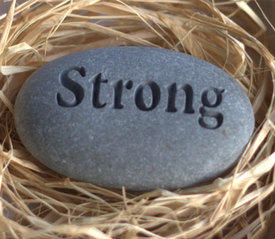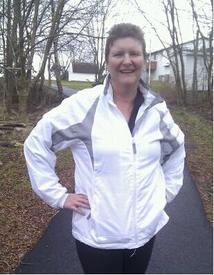i need some information from runners please

Megdmcda
Posts: 273 Member
ok my dilema is guessing how fast i'm jogging. ok so inside i can jog 15 min straight in place. breathing totally normal little out by the end of 15 min. i'm guessing that because i burned 12 calories per min, that its the same as the 5 mile per hour outside because it was 12 per min as well. but when i'm jogging out side i get to a min and i can't breathe at all and my sides are hurting. now i switch it doing two laps walking and then two laps jogging. now to me i feel like i'm doing close to me running but not quite running yet. and its definately not my slow jog. because i did one just to see. and i'm definately going faster. so my question is how fast should i log my jogging. i looked up what the average is and i read 8-10. i'm pretty sure i am not going that fast. i'm guessing 6 to 6.5. please help. i want to log it right. and as of right now i don't have a way to actually measure. because obivously i can't do it very long right now. lol
i have NO MONEY at all to be buying any thing. i can't afford a heart rate moniter or anything else....i just need a guestimate of how fast i'm running so i know how to long it in now. so will someone tell me if my guess is right or wrong. the way some of u are explaining i'm running at about a mile an hour...sorry for the abruptness.....just kinda frustrated right now.
i have NO MONEY at all to be buying any thing. i can't afford a heart rate moniter or anything else....i just need a guestimate of how fast i'm running so i know how to long it in now. so will someone tell me if my guess is right or wrong. the way some of u are explaining i'm running at about a mile an hour...sorry for the abruptness.....just kinda frustrated right now.
0
Replies
-
The easiest way would be to time yourself running/jogging your lap then you can break it down to mph. As you probably know, 4 laps equal 1 mile on a standard track. Or just time yourself for your entire workout for 4 laps and that's pretty much an average of what you are doing especially since it seems like you are doing two laps of each walking/jogging.0
-
The easiest way would be to time yourself running/jogging your lap then you can break it down to mph. As you probably know, 4 laps equal 1 mile on a standard track. Or just time yourself for your entire workout for 4 laps and that's pretty much an average of what you are doing especially since it seems like you are doing two laps of each walking/jogging.
well its not a standard track. lol i'm jogging an outside basketball court. i don't know how many laps that would take to make a mile...and i pretty sure its about 45 seconds to jog the two laps. but i currently don't have my timer. i was out a total of 37 min today. i halfed that...and put an extra 4 on the walking for the walk to and from the court to my apartment. so i figured it at about 22 walking and 15 jogging.0 -
You should get a Heart Rate Monitor. Even if you know how fast you are going, average estimators can be waaay off. Heart rate monitors tell you exactly how many calories you burn.0
-
well its not a standard track. lol i'm jogging an outside basketball court. i don't know how many laps that would take to make a mile
Well if you were running around an NBA court, about 19 times (exactly 18.3). Around a normal high school or college court, about 20 (exactly 19.7). (from Yahoo Answers).0 -
Try using an app such as Nike+GPS or mapmyrun or something similar. Or time your laps as suggested.
Sounds like you have some weak core muscles from the pain and problems your describing too... get to work with that... situps, plank, crunches, stability ball, pushups... plus weights! Calisthenics are cheap as you don't need any equipment!0 -
A heart rate monitor is the only way to get an pretty accurate amount of calories you are burning. However, if you don't want to fork over the cash, then I would recommend finding a standard tack to get as close as you can without a HRM purchase.0
-
A heart rate monitor is the only way to get an pretty accurate amount of calories you are burning. However, if you don't want to fork over the cash, then I would recommend finding a standard tack to get as close as you can without a HRM purchase.
And definitely erring on the side of caution when eating calories back. :ohwell:0 -
Agree with HRM recommendation. Also, look at doing HIIT to improve your endurance. It will help you get in shape a lot faster than straight cardio
 0
0 -
Agree with HRM recommendation. Also, look at doing HIIT to improve your endurance. It will help you get in shape a lot faster than straight cardio

what's the hiit?0 -
High Intensity Interval Training also called Tabata.0
-
simple

Do you have a watch?
I just googled the size of a basketball court, and the international sizing is 94 x 50 feet, but it said most basketball courts in high schools are smaller.
So I'm guessing your using a smaller basketball court of 84 feet x 50 feet.
So one lap of the basketball court is 268 feet. 10 laps would be 2680 feet, which is approximately half a mile.
How long does it take for you to run 10 laps of the basketball court? Let's say its 5 minutes - so that means you are running at 10 minutes per mile, or 6 miles per hour 0
0 -
tl;drAgree with HRM recommendation. Also, look at doing HIIT to improve your endurance. It will help you get in shape a lot faster than straight cardio
what's the hiit?
Steady-state cardio is generally pointless, unless done fasted. HIIT is better in every way. Strength training generally yields even better results than HIIT.
HIIT = high-intensity interval training (sometimes called 'sprints')... alternating periods of intense, all-out effort and low-intensity, e.g. sprint for 30 seconds, walk for 30 seconds, repeat. It will build up your endurance a LOT more quickly, as well as generally being a lot more effective, even when done for substantially shorter periods of time.
TBH, having done more research on fitness than is healthy, I would not recommend (non-fasted) cardio to anyone wanting to lose weight, unless you have enough time to do 3 hours/week of weight training first (it burns calories, but isn't really any more effective than just reducing your caloric intake by a comparable number of calories). Fasted cardio is quite effective for fat loss, but also very tough physically and psychologically. HIIT has an anaerobic element in addition to building better endurance (recovery from anaerobic energy expenditures have been estimated at something like 4-5 cals per calorie burned anaerobically, which is part of why weight training produces such huge results for most people... HIIT lets you tap into that as well).
Basically, here is how I partition my own workout time:
first 3 hrs/week: Weights (3 days/week is all you need)
next 4 hrs/week: Fasted cardio. If recovery permits, fasted HIIT (~10 mins)+low-intensity cardio (30-40 mins). You can eat right after you finish.
Any more than that: Low-intensity cardio (walking or suchlike) and/or yoga.
Diet+3 hrs/week of weights can get you to any fitness level you want (it would start to get hard at around 15-18% body fat for a woman, and at that point I would recommend adding fasted cardio if further fat loss were desired).
Probably WAY TMI for you, but hopefully this is helpful. 0
0 -
Until you get a chance to run a measured course I would recommend you log the running at 12 min/mile. That is probably pretty close as it is around what most people are running when they start out. Even if it's not exact, it's close enough that the difference in calorie burn would be negligible.0
-
simple

Do you have a watch?
I just googled the size of a basketball court, and the international sizing is 94 x 50 feet, but it said most basketball courts in high schools are smaller.
So I'm guessing your using a smaller basketball court of 84 feet x 50 feet.
So one lap of the basketball court is 268 feet. 10 laps would be 2680 feet, which is approximately half a mile.
How long does it take for you to run 10 laps of the basketball court? Let's say its 5 minutes - so that means you are running at 10 minutes per mile, or 6 miles per hour
ha ha thank u. that is exactly what i wanted to know. ok so i did 6 laps at about 2 and half min. ha ha i'm so frazzled... help me w the math? lol 0
ok so i did 6 laps at about 2 and half min. ha ha i'm so frazzled... help me w the math? lol 0 -
You can use runkeeper or mapmyrun(google them) to map the route that you run abdvit will tell you how many km (or miles) you have run. Once you know the distance, you can workout your speed.
Running outside is different to a treadmill - I suggest that you slow down. Work on your endurance first and then speed can come later.0 -
Until you get a chance to run a measured course I would recommend you log the running at 12 min/mile. That is probably pretty close as it is around what most people are running when they start out. Even if it's not exact, it's close enough that the difference in calorie burn would be negligible.
thank u....that sounds good. 0
0 -
It doesnt matter how fast, only how far. If you run a mile in 5 minutes or 20 minutes you have still burned the same number of calories. So the easy way is just to figure your mileage and tweak the time entry to match. Most folks burn about 100 calories per mile.0
-
It doesnt matter how fast, only how far. If you run a mile in 5 minutes or 20 minutes you have still burned the same number of calories. So the easy way is just to figure your mileage and tweak the time entry to match. Most folks burn about 100 calories per mile.
This is incorrect: the higher your heart rate, the more calories you burn over the same distance. Which is why running is slightly more effective for burning calories than walking the same distance.
Also, I only burn about 75 cals for every runned mile, so you are off by 25%.
THIS IS WHY you shouldn't make generalizations about how many calories are burned.:grumble:0 -
use www.mapmyrun.com to log your distance. Once you know how far you've gone, and how long it took you, you can figure out how fast you were going.
But as a general rule of thumb, it's about 100 - 125 calories per mile, regardless of speed.
http://www.runnersworld.com/article/1,7120,s6-242-304-311-8402-0,00.html
Here's an article to support the 100 calorie per mile theory.0 -
It doesnt matter how fast, only how far. If you run a mile in 5 minutes or 20 minutes you have still burned the same number of calories. So the easy way is just to figure your mileage and tweak the time entry to match. Most folks burn about 100 calories per mile.
This is incorrect: the higher your heart rate, the more calories you burn over the same distance. Which is why running is slightly more effective for burning calories than walking the same distance.
Also, I only burn about 75 cals for every runned mile, so you are off by 25%.
THIS IS WHY you shouldn't make generalizations about how many calories are burned.:grumble:
I beg to differ. I run with a HRM. I run a lot. I have a dozen 1/2 marathons and 4 marathons under my belt. I was training for an ultra before I got pregnant. A mile is a mile, your calorie burn will not change for that mile whether you run it fast or slow. After a time, you will be in better shape, and your calorie burn per mile will drop. Before I got pregnant I burned 90 calories per mile and now I burn about 110 calories per mile.0 -
It doesnt matter how fast, only how far. If you run a mile in 5 minutes or 20 minutes you have still burned the same number of calories. So the easy way is just to figure your mileage and tweak the time entry to match. Most folks burn about 100 calories per mile.
This is incorrect: the higher your heart rate, the more calories you burn over the same distance. Which is why running is slightly more effective for burning calories than walking the same distance.
Also, I only burn about 75 cals for every runned mile, so you are off by 25%.
THIS IS WHY you shouldn't make generalizations about how many calories are burned.:grumble:
I beg to differ. I run with a HRM. I run a lot. I have a dozen 1/2 marathons and 4 marathons under my belt. I was training for an ultra before I got pregnant. A mile is a mile, your calorie burn will not change for that mile whether you run it fast or slow. After a time, you will be in better shape, and your calorie burn per mile will drop. Before I got pregnant I burned 90 calories per mile and now I burn about 110 calories per mile.
Science would disagree with you (and yeah, I ALSO run with a HRM):
http://walking.about.com/od/calorie1/a/calorieswalkrun.htm
"Calories per Mile for 160 Pound Person
Walking
2.0 mph - 91
2.5 mph - 87
3.0 mph - 85
3.5 mph - 83
4.0 mph - 91
4.5 mph - 102
5.0 mph - 116
Running
5.0 mph - 116
6.0 mph - 121
7.0 mph - 119
8.0 mph - 123
9.0 mph - 121
10.0 mph - 131"
As you can see, if she were to walk 3 mph she would burn only 70% of what she would burn running 6 mph (both of which are reasonable assumptions).0
This discussion has been closed.
Categories
- All Categories
- 1.4M Health, Wellness and Goals
- 398.2K Introduce Yourself
- 44.7K Getting Started
- 261K Health and Weight Loss
- 176.4K Food and Nutrition
- 47.7K Recipes
- 233K Fitness and Exercise
- 462 Sleep, Mindfulness and Overall Wellness
- 6.5K Goal: Maintaining Weight
- 8.7K Goal: Gaining Weight and Body Building
- 153.5K Motivation and Support
- 8.4K Challenges
- 1.4K Debate Club
- 96.5K Chit-Chat
- 2.6K Fun and Games
- 4.7K MyFitnessPal Information
- 17 News and Announcements
- 21 MyFitnessPal Academy
- 1.5K Feature Suggestions and Ideas
- 3.2K MyFitnessPal Tech Support Questions








